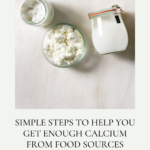Last updated on May 5th, 2023 at 02:05 pm
In today’s world, we are constantly barraged with one hundred more ways and suggestions on ” getting more calcium” (which generally involves highly processed dairy products and supplements). In fact, most of us already get enough calcium from food sources (especially if we are eating a nutrient-dense diet). Still, we are simply missing the cofactors that allow the body to absorb calcium for use and function.
Calcium is one of the most important minerals in the body, and it is safe to say that our lives depend on calcium. The body needs calcium for many functions, including:
- nerve impulse
- bone and teeth support
- muscle contractions
- white blood cell function
- reducing inflammation
- blood coagulation
Another hot surrounding calcium. The body needs calcium for strong bones (this is true to an extent), but research also shows that you need other nutrients like fat-soluble Vitamins A, C, D, and K, magnesium, manganese, phosphorus, amino acids, and enzymes for building healthy bones.

How to maximize the absorption of calcium from food sources?
In short, there are seven cofactors the body needs to absorb and use calcium effectively – this is the same whether you get calcium from food sources or supplements.
Hydration
Proper hydration ensures the blood is fluid enough to efficiently transport calcium throughout the body to other tissues.
Other Minerals
Calcium must be in balance with the other macrominerals. Moreover, the body also needs potassium and the trace elements zinc, boron, copper, and manganese to properly use calcium.
Systemic PH
The body will pull calcium from the tissues if the blood is too acidic. Also, if the blood becomes too alkaline, calcium separates out of solutions.
Fatty Acids
Fatty acids are necessary to transport calcium across the cell membrane into the cell. Furthermore, they also help increase calcium in tissues.
Vitamin D
Vitamin D works with parathyroid hormone (PTH) to increase calcium in the blood serum. It increases absorption through the gastrointestinal tract, pulls calcium from the bones and tissues, and decreases loss in the urine and feces.
Digestion
Calcium needs an acidic environment for absorption. It requires the right amount of hydrochloric acid (stomach acid) for uptake. Moreover, calcium needs a 4-4.5 pH in the stomach for the body to pull and use the mineral properly from the food source.
Hormones
The body is dependent on different hormones to regulate calcium absorption and utilization.
- parathyroid hormone is the primary hormone that regulates blood calcium levels.
- thyroid hormone inhibits osteoclastic activity and decreases blood calcium levels.
- adrenal hormones like mineralocorticoids control sodium and potassium homeostasis directly relate to calcium.
- sex hormones like estrogen inhibit osteoclastic activity, progesterone promotes osteoblastic activity, and testosterone is a precursor to estrogen and progesterone.
Here you can see that it is a much more complicated process than simply taking a calcium supplement.
Learning so much information can be pretty overwhelming, but that is why I am here to help you break it down into simple, digestible steps.

Simple steps to help your body absorb and utilize calcium
1. The first step (and critical step, in my opinion) is to reduce your stress so that your digestive system can produce the correct amount of stomach acid to absorb and use the calcium in your diet.
2. Do your best to reduce artificial sugar, alcohol, and caffeine consumption. In general, these three foods reduce calcium in the body.
3. Refrain from over-exercising. In fact, too much exercise can deplete your calcium stores.
4. Ensure you get the correct calcium form from real food sources. After all, processed foods “enriched” with calcium use a synthetic form that the body doesn’t process and use optimally.

Bioavailable food sources of calcium:
- raw dairy (will always be superior)
- soaked or sprouted nuts and seeds
- oily fish – sardines
- cooked leafy greens – kale, collard greens, turnip greens, dandelion greens, spinach
- parsley
- apricots
- brewer’s yeast
- eggshell powder
- pearl powder
Please note: If you choose to take a calcium supplement, you must know that there are different kinds of calcium supplements on the market. The most common ones are calcium citrate, lactate, and carbonate. As a matter of fact, calcium carbonate is the most popular- even though this form is not easily digested. As a result, it is poorly assimilated by the body. This is why I always suggest that you talk to your practitioner so they can help you find the best supplement for your body.
As you can see, calcium is an essential mineral with many functions. I hope this article was helpful in teaching you on how to get the most our of your calcium from food sources.
Disclaimer: This post is not intended to provide medical advice, diagnosis, or treatment and is for educational purposes only.
Use code “NURTUREMEWILD” at checkout to save 10% off your first order at Wild Wholistic!





+ view comments